Garden Glimpses: A (Too) Early Spring
First, let me say that I totally renounce and disown that charlatan rodent weather prognosticator, Punxsutawney Phil, who on Groundhog Day 2023 predicted six more weeks of winter. He’s often wrong, and I’ve tried to defend him in the past, but he has been so colossally off the mark this year that I can no longer continue with his charade. On the other hand, if by that prediction, he meant “six more weeks of the same,” then he’s been spot on!
It’s been an incredibly warm winter in eastern Pennsylvania; in fact, alarmingly so. Normal high for January and February would range from upper 30s to mid-40s, but we’ve had over thirty days of 50-plus so far, and another half dozen over 60. This week, we’ll make a run at 70. The temps have seesawed, with roughly one day of winter per week to break up the monotony of this slow-rolling eternal spring. We even had a polar vortex at Christmas, sending temps plummeting below zero, which did more harm than good, but typical wintry conditions of snow and ice have been completely absent, barring a few light dustings in December.
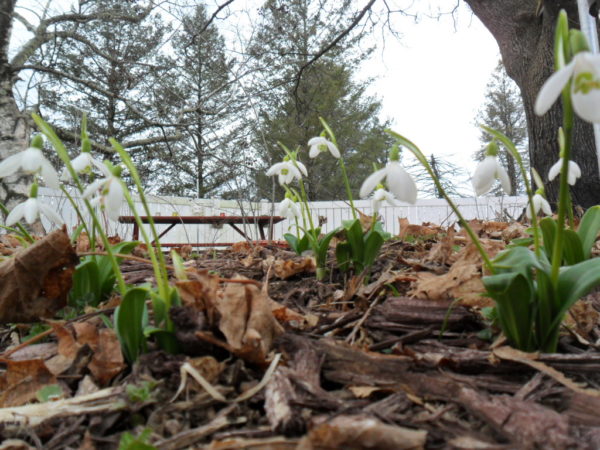
As someone who loathes shoveling and pays to have the driveway plowed, I couldn’t be happier. But as a plantsman and realist, I understand that none of this is good news. And it’s yet another sign of the havoc that global climate change is having on our regional ecosystems.
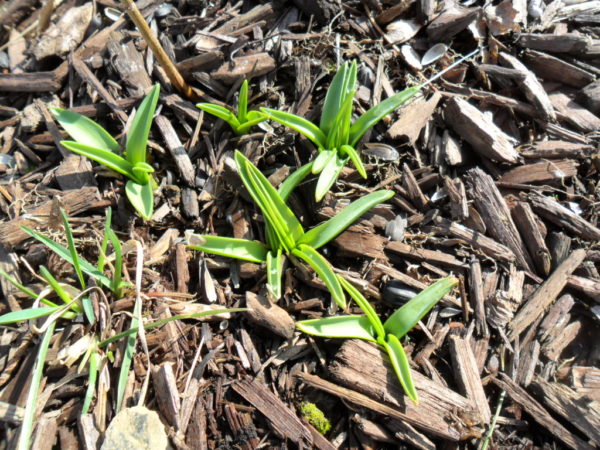
Sudden shifts in temperature create difficult conditions for many plants, as the water in their cells freezes too quickly, with ice crystals piercing cell walls, which then drain upon thawing, potentially killing the plant. Many species require a period of bitter temps for seed germination, and a heavy snowpack, far from being injurious, insulates tender roots, bulbs and rhizomes from desiccating winter winds. Plants that unfurl their buds too early will likely freeze them off again, retarding future bloom or growth. Insect populations will be on the rise for 2023 as well, able to overwinter in larger numbers than normally. I’ve seen stinkbugs all season long, and even some spotted lanternfly nymphs, and the occasional mosquito!

My spring bulbs are running way ahead of schedule this year, and as lovely as it is to see bright, festive colors splashing the dun brown winter landscape, they just shouldn’t be here in February. That said, we may as well enjoy them while they last, because who knows when the next polar vortex will descend from Canada and wipe out everything in its path?
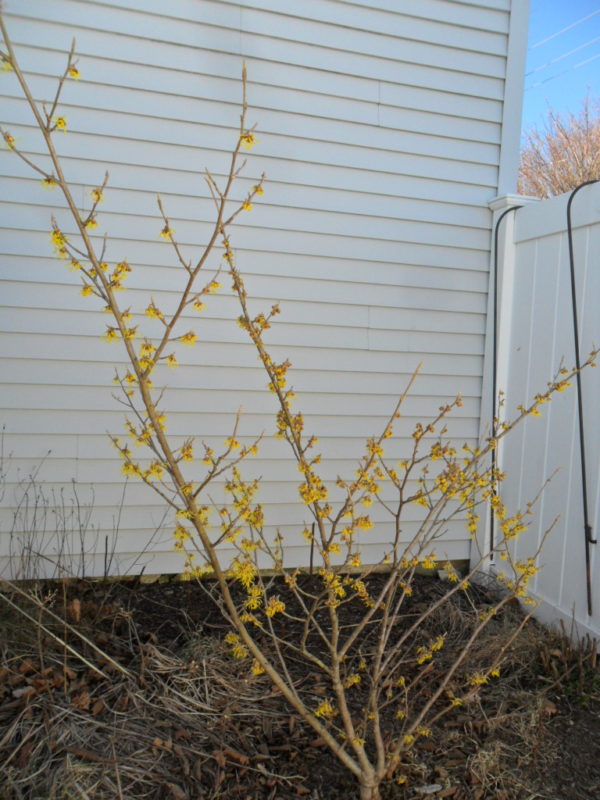
As always, my lovely witch hazel was the first to flower, bursting forth with its spidery yellow blooms on February 5th, over two weeks earlier than last year. I’m not worried about this small ornamental tree, however – as delicate as the flowers may appear, witch hazel is perfectly capable of fending off anything Mother Nature can dish out.
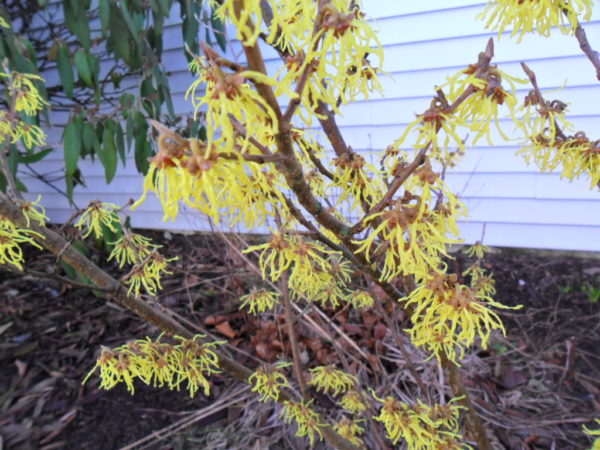
Last year we had a heavy ice storm a couple weeks after it began blooming, and the flowers were quickly encased in a thick, transparent coating, like artificial blooms embedded in glass. But when the sun came back out, and the temps rose above freezing, they reemerged, looking fresh as the day they opened. Due to the cooler overall temps, witch hazel has a long bloom period lasting up to a month, filling in the gap in floral display until the earliest crocus and snowdrops are up to speed.

This year, not so much gap to fill. I had diminutive snowdrops unfurling just a few days later, over a month before expected. Those have since grown to full size, their bell-like blooms dangling six broadly-splayed downturned white tepals with pale green dots on the inner, smaller ring of three. Botanical name Galanthus, snowdrops hail from southern Europe and the Middle East, and there are approximately 20 species in the genus.
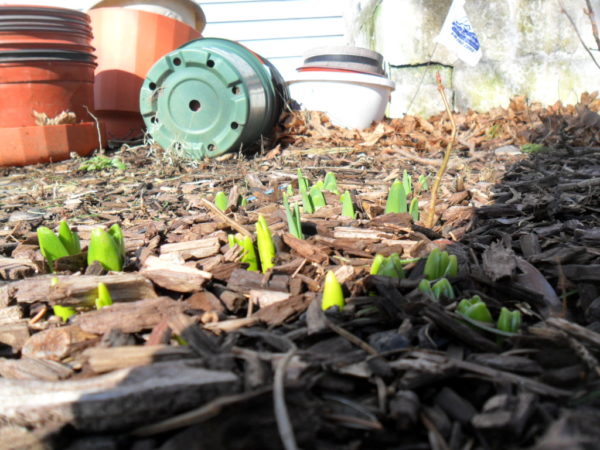
I’m pleased to note that this bed is starting to fill in, after a couple years of just holding its own, and even more pleased to confirm that yes, they will thrust up even through the blanket of dried maple leaves I never removed last fall. Dare I hope that my raking days are over?
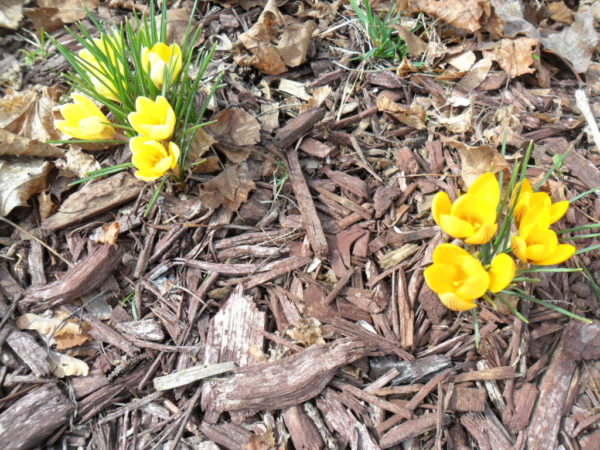
Close behind, just a day or two later, came the snow crocus. At this point, it’s only the yellow varieties that have opened, bright cups of golden yellow that close at night or in cloudy conditions, streaked on the outside with thin vertical stripes of purple-rust. These have expanded their range also, though intermingled with later-blooming versions in white, buttercream, and purple, they still look like islands of color in a bleak setting. The snow crocus, or Crocus chrysanthus, is native to the Balkans and Turkey, the progenitor of its larger, more diverse cousins, the Dutch crocus, which bloom weeks later.
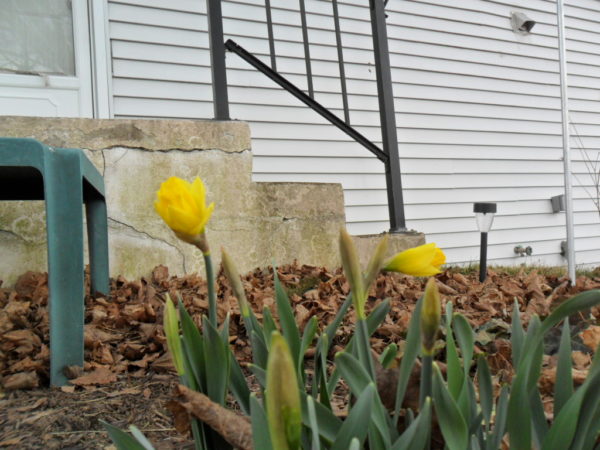
I was especially rattled to find narcissus forming buds in late January. Leaf tips of these spring staples will begin to erupt from the soil as early as December if conditions are right, but to form buds as early as this is unheard of. Not all my daffodils are such early birds, thank goodness, but most are up to one degree or another.
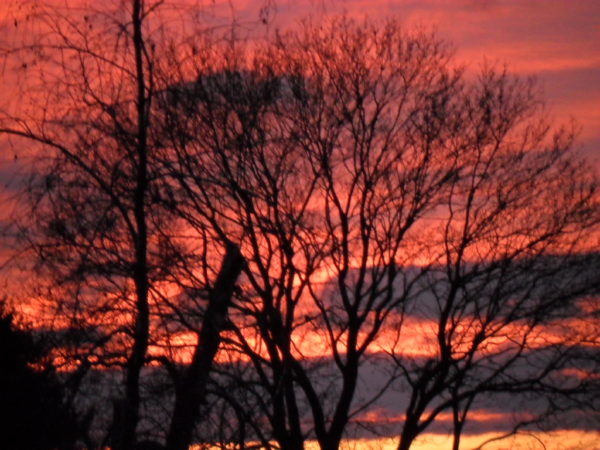
This particular patch is by the rear stoop off the kitchen, a protected space, but not unduly so. Last year they were the first to bloom as well, but not nearly as early as this. I can’t tell you the variety – it was to have been Ferris Wheel, a large-cupped narcissus with bright yellow petals and a deep orange trumpet, but the grower sent something else in error. These are large, yes, but completely monochrome, in a bright sunny yellow. They actually opened on Valentine’s Day, the earliest I have ever seen a blooming daffodil in these latitudes.

Originating in the Iberian peninsula, there are more than 50 species that occur naturally in the Mediterranean basin, but hybridization has yielded hundreds of varieties. I have approximately 60 different kinds in my garden, including mini versions and heirlooms that have been on the property since the early ‘70s.

Not to be outdone, just a bit further down that same bed I’m seeing a few tentative deep purple blooms of iris reticulata, another bulb plant that is way ahead of schedule. It has the grace to form a pleasing counterpoint to the yellow daffodils, but its emergence now is another sign that things just aren’t right. I’m currently seeing just two blooms in a fair-sized patch, and I’m uncertain if these are just a few outliers or if last year’s extreme drought has negatively impacted their output. The leaves look normal, we’ll just have to see how it plays out.
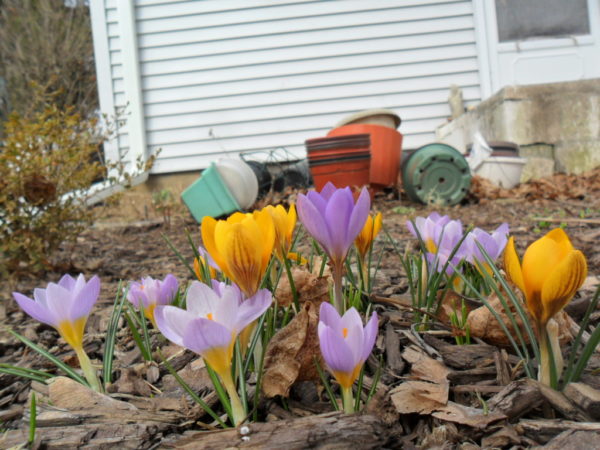
Iris reticulata is the first to bloom in the genus, native to eastern Turkey and Iran, but widely cultivated in temperate regions across the globe. They come in shades of yellow, blue and purple, typically with small orange splashes of color on the three falls, the downward-curved petals which surround the inner uprights.
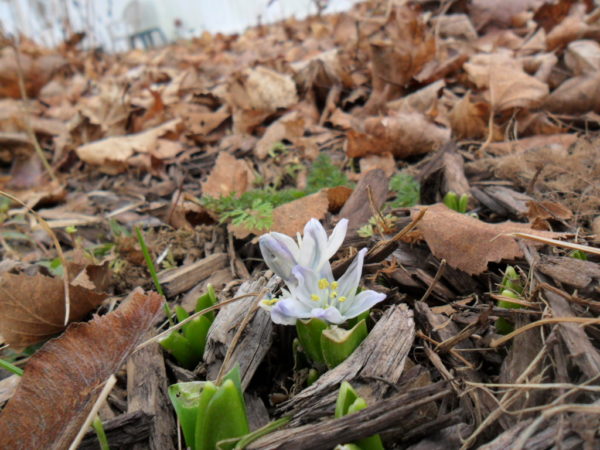
But perhaps the most shocking early bloomer is my scilla mischtschenkoana, AKA “white squill,” a stunning low grower sending spikes of brilliant white star-shaped flowers about 4-5” high. “Mitchy,” as I call her, tends to bloom early, but not this early. Flower spikes emerge early, too, just as the leaves are beginning to show, and typically bloom before the foliage is fully leafed out. In this case, I have just a single flower spike from six patches distributed throughout the east bed, with three diminutive blossoms so close to the ground as to be almost invisible amidst the surrounding leaf mulch. None of the other patches are showing signs yet, so I’m hopeful we’ll have a normal, if premature, showing from these, one of my very favorite plants in any season. Scilla mischtschenkoana is another native of the southern Caucasus and Iran, a region which also gave us the ubiquitous tulip.
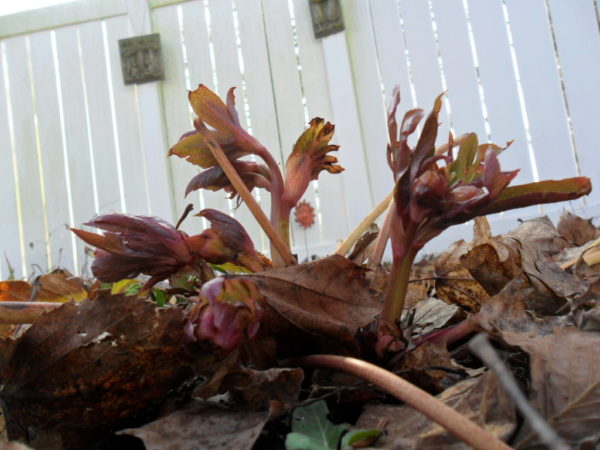
The last flowering plant on my “early bird special” list is hellebore, of which I have five varieties. Known also as Lenten Rose, these exotic-looking beauties are so-named from their habit of blooming weeks before Easter, a rarity in a plant as tall and fleshy as this, with heights ranging to about 18” tall. As this is their first spring here, I’m not sure how to rate their performance in terms of timeliness. Although the plant is almost evergreen, with the prior year’s foliage not fully dying back until the new year’s growth emerges, and is thus used to extremes of temperature, these seem to have taken somewhat of a beating from that polar vortex. I did take the opportunity to mulch them with maple leaves at the time, and they’re definitely alive, but, to use the technical term, they look a bit “wonky.” Only four are showing signs of life, but it’s vigorous; the fifth, which struggled throughout the growing season last year, I may have lost.
Hellebores are native to Europe and Asia, with the highest concentration of species in the Balkan region. Mine are a lively mix of burgundy, pink, yellow and chartreuse colors, and I can’t wait to see the full display.
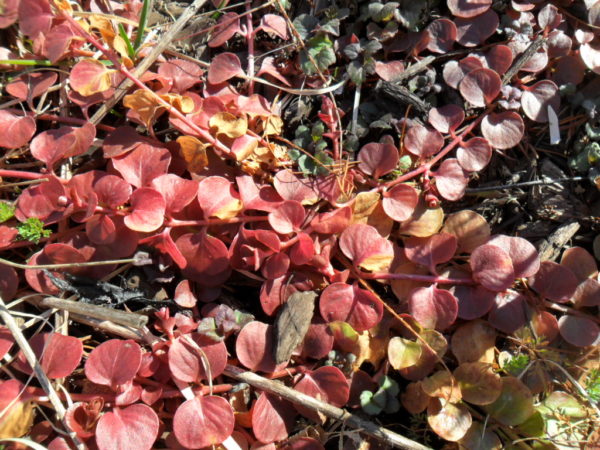
So far, that’s it for the already-emergent spring bloomers, but there are signs that other flora are running ahead of schedule as well. Creeping jenny, a low, vining groundcover that is lime-chartreuse in partial shade but flares to golden in full sun, first emerges as a dull burgundy-brown, a startling contrast to its mature color. I typically don’t see this until mid-March or later, but it’s up and doing already.
My sedum “Touchdown Teak” is active as well, sending out new nodes of bright hot pink, so vibrant as to seem artificial. Touchdown Teak will tone it down as it matures, but retains purple-burgundy foliage throughout the season, and offers clusters of minuscule starlike two-toned pink and coral blossoms in early summer.
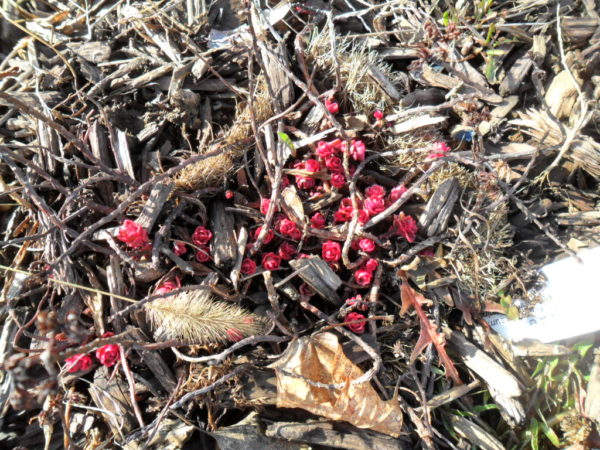
Irish moss is another favorite showing signs of rejuvenation after its winter slumber. This low-growing ground cover is well-adapted to partial shade, forming a dense mat of lime green that keeps down weeds remarkably well. It will tolerate light foot traffic but prefers to be left alone, creating ever-expanding islands of eye-soothing green. It will be studded with diminutive cuplike white blossoms in late spring, with occasional random rebloom later in the season. Right now its straw-colored winter coat is regreening, emerging a lovely chartreuse.

Many other bulb plants are poking nosy fingers through the soil as well, including various types of muscari, hyacinths and tulips. I’m seeing some slight greening at the crowns of the daylilies, last year’s native aster clumps are putting out new growth at the base, and tiny Queen Anne’s Lace seedlings sprouting everywhere predict a spring agenda of heavy weeding.
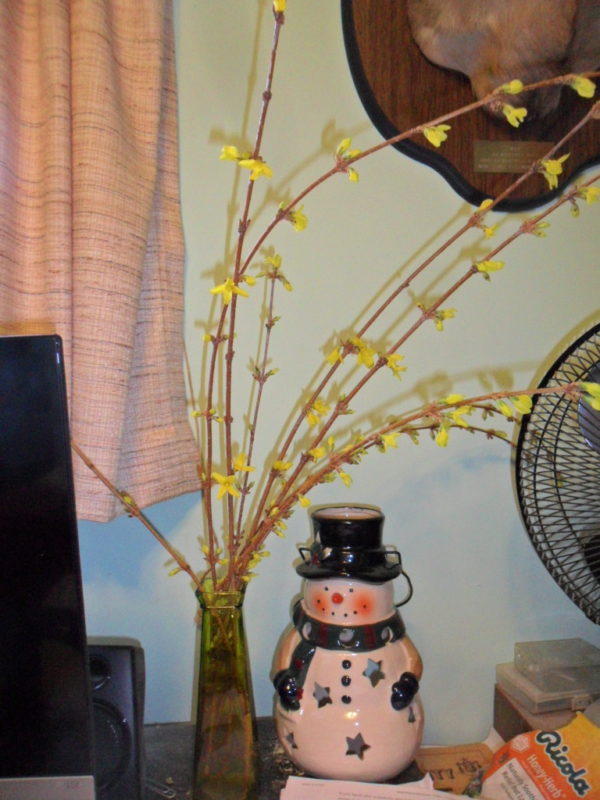
What aren’t I seeing? Dandelion. And I can tell you, I’m in no rush for those!
It’s too soon yet to know what the effect of this early spring will be; much depends on the weather to follow. If it remains temperate, I suppose it’s a case of “no harm, no foul,” but if temps dip again at crucial stages or we get heavy snow or ice, I could be robbed of some of my most highly-anticipated blooms of the year.
We’ll just have to wait and see…
ADDENDUM
And the wait wasn’t long! This article was slated to post on February 25th, but looking at the forecast, I elected to wait until after a predicted snowstorm on the 27th. Sure enough, we got about four inches of snow and sleet, burying my tender blossoms. I wasn’t able to cover everything, but I did make the effort to place pots and wash basins over two patches of crocus that were just getting started, and also covered the hellebores that are showing buds. They could probably handle it, but as their first year here, I wasn’t talking any chances! The main crocus bed was too large to cover, but as the name implies, “Snow Crocus” is somewhat used to these conditions, and has the advantage of folding its tender blooms at night, making them less vulnerable to snow damage than fully splayed blossoms would be. Nothing has been uncovered yet since we’ll be getting random snow showers throughout the morning, but I did slip out to snap a few pics. Looks like winter has finally arrived!
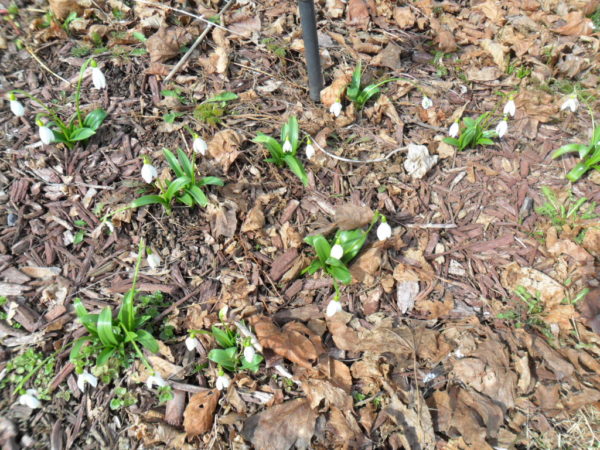
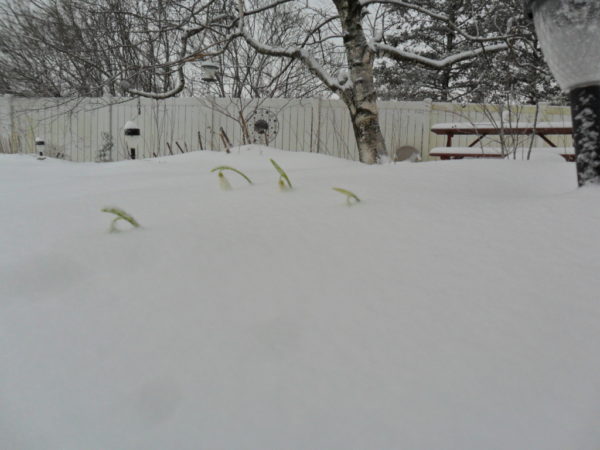
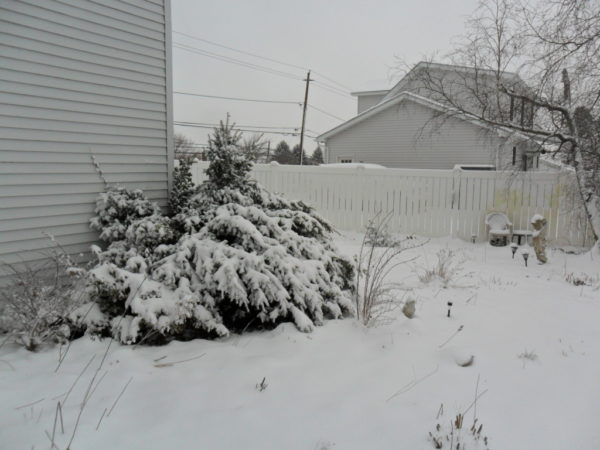
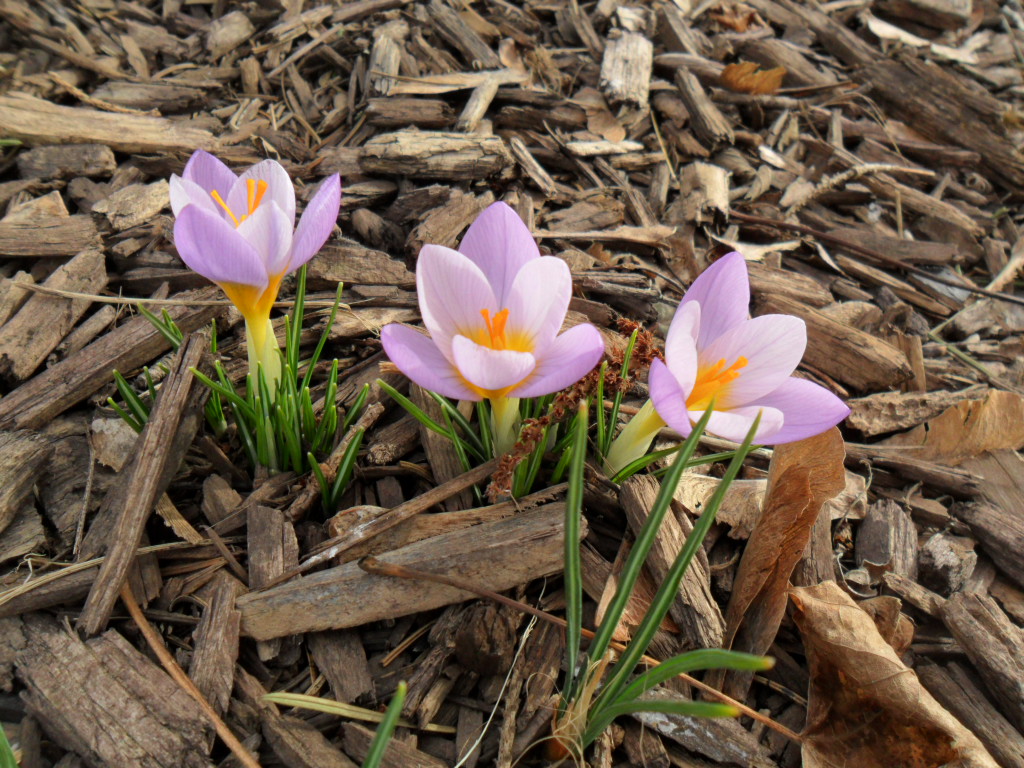

3 comments, add yours.
Irmgard Dering
You must be terribly disappointed — all that beauty gone!
Thank you for the video!
Therese
Beautiful pictures, Alex. I have a hellebore that finally bloomed last season after six years…one single bloom, which was promptly eaten by a bunny (I don’t even mind!)
We live in zone 6a in MA but joke that zone 7 calls us every now and then to say “slow down up there!” We’re in the middle of a snow dump as I type.
Laurien
How sad! I hope your flowering bulbs survive the snow. The photos of them were lovely. Hope your 5th hellebore makes it. Glad your witch hazel is so hardy. I remember when its blooms were encased in ice. I have read that last year’s Hunga Tonga eruption is likely to blame for our cold North American winter not to mention weather phenomenon in other parts of the world like Cyclone Gabrielle and the effect may last several years. Hopefully our gardens survive! Thanks for sharing this, Alex!